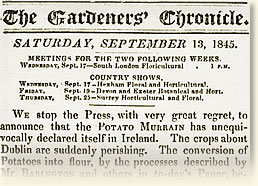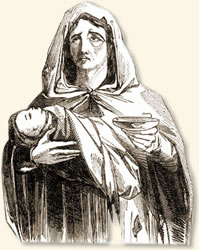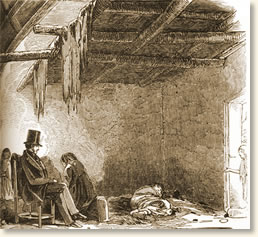|
The Irish Potato Famine, 1847
The potato was not native to Ireland. It is believed that Sir Walter Raleigh brought the tuber to the island from the New World around 1570. No one could foresee that its arrival was the first ingredient in a recipe that would simmer for 275 years and produce a disaster: the deaths of thousands, the devastation of the Irish economy and the Irish Diaspora that scattered the Irish people around the globe.
 |
An Irish newspaper annouces
the arrival of the blight
September 13, 1845 |
At first, the potato seemed heaven-sent. It thrived in the damp Irish climate,
was easy to grow and produced a high yield per acre. In the period from 1780
to 1845 it helped double the Irish population from 4 to 8 million. However, with
this population explosion came an increased demand for land. The only solution
was to divide the available parcels into ever smaller plots for each succeeding
generation. Soon, the diminished size of these plots dictated the planting of
potatoes as it was the only crop that could produce a sufficient yield of food
on such limited acreage. By 1840, fully 1/3 of Ireland's population was totally
dependent on the potato for its nourishment. It was a dependency that teetered
on the brink of starvation and created a time bomb that needed only the slightest
spark to explode.
The spark that lit the fuse was the arrival in September 1845 of the potato blight.
Brought ashore from the cargo holds of ships, the blight quickly made its way
to the potato fields where it spread havoc. One third of the crop was lost
that year. This escalated to a loss of 3/4 of the crop in each of the two succeeding
years. The small farmers suffered immediately. Starvation combined with an
increased susceptibility to diseases such as typhus, dysentery and cholera
devastated the population. The reaction of the British government was inadequate.
By 1848, the worst was over but the devastation lingered on for a number of
years. It is estimated that between 500,000 and 1.5 million people died as
a result of the famine while over one million fled the country. By 1911, Ireland's
population had dropped to four million.
James Mahoney was an artist living in Cork, Ireland.
In early 1847 he was asked by the Illustrated London News to tour the surrounding
countryside and report on what he saw. The resulting articles and illustrations
did much to alert the British public of the crisis. We join Mahoney's account
as he journeys to the village of Skibbereen in the south of Ireland:
 |
Mahoney's sketch
of the woman and child |
"I started from Cork, by the mail, for Skibbereen and saw little until we came to Clonakilty, where the coach stopped for breakfast; and here, for the first time, the horrors of the poverty became visible, in the vast number of famished poor, who flocked around the coach to beg alms: amongst them was a woman carrying in her arms the corpse of a fine child, and making the most distressing appeal to the passengers for aid to enable her to purchase a coffin and bury her dear little baby. This horrible spectacle induced me to make some inquiry about her, when I learned from the people of the hotel that each day brings dozens of such applicants into the town.
After leaving Clonakilty, each step that we took westward brought fresh evidence of the truth of the reports of the misery, as we either met a funeral or a coffin at every hundred yards, until we approached the country of the Shepperton Lakes. Here, the distress became more striking, from the decrease of numbers at the funerals, none having more than eight or ten attendants, and many only two or three.
We next reached Skibbereen... We first proceeded to Bridgetown...and there I saw the dying, the living, and the dead, lying indiscriminately upon the same floor, without anything between them and the cold earth, save a few miserable rags upon them. To point to any particular house as a proof of this would be a waste of time, as all were in the same state; and, not a single house out of 500 could boast of being free from death and fever, though several could be pointed out with the dead lying close to the living for the space of three or four, even six days, without any effort being made to remove the bodies to a last resting place.
After leaving this abode of death, we proceeded to High-street, or Old Chapel-lane and there found one house, without door or window, filled with destitute people lying on the bare floor; and one, fine, tall, stout country lad, who had entered some hours previously to find shelter from the piercing cold, lay here dead amongst others likely soon to follow him. The appeals to the feelings and professional skill of my kind attendants here became truly heart-rending; and so distressed Dr. Donovan, that he begged me not to go into the house, and to avoid coming into contact with the people surrounding the doorway...
Next morning...I started for Ballidichob, and learned upon the road that we should come to a hut or cabin in the parish of Aghadoe, on the property of Mr. Long, where four people had lain dead for six days; and, upon arriving at the hut, the abode of Tim Harrington, we found this to be true; for there lay the four bodies, and a fifth was passing to the same bourne. On hearing our voices, the sinking man made an effort to reach the door, and ask for drink or fire; he fell in the doorway; there, in all probability to die; as the living cannot be prevailed to assist in the interments, for fear of taking the fever.
We next got to Skull, where, by the attention of Dr. Traill, vicar of the parish (and whose humanity at the present moment is beyond all praise), we witnessed almost indescribable in-door horrors. In the street, however, we had the best opportunity of judging of the condition of the people; for here, from three to five hundred women, with money in their hands, were seeking to buy food; whilst a few of the Government officers doled out Indian meal to them in their turn. One of the women told me she had been standing there since daybreak, seeking to get food for her family at home.
This food, it appeared, was being doled out in miserable quantities, at 'famine prices,' to the neighbouring poor, from a stock lately arrived in a sloop, with a Government steamship to protect its cargo of 50 tons; whilst the population amounts to 27,000; so that you may calculate what were the feelings of the disappointed mass.
 |
The Vicar sits while Mullins lies in
the corner. Mullins died and 3 days
later, so too did the Vicar.
|
Again, all sympathy between the living and the dead seems completely out of the question... I certainly saw from 150 to 180 funerals of victims to the want of food, the whole number attended by not more than 50 persons; and so hardened are the men regularly employed in the removal of the dead from the workhouse, that I saw one of them, with four coffins in a car, driving to the churchyard, sitting upon one of the said coffins, and smoking with much apparent enjoyment. The people also say that whoever escapes the fever is sure of falling sick on the road (the Public Works), as they are, in many instances, compelled to walk from three to six miles, and sometimes a greater distance, to work, and back again in the evening, without partaking of a morsel of food. Added to this, they are, in a great number of instances, standing in bogs and wet places, which so affects them, that many of the poor fellows have been known to drop down at their work."
The editors of the London Telegraph make a comment on Mahoney's observations:
"A specimen of the in-door horrors of Scull may
be seen in the annexed sketch of the hut of a poor man named Mullins, who lay
dying in a corner upon a heap of straw, supplied by the Relief Committee, whilst
his three wretched children crouched over a few embers of turf, as if to raise
the last remaining spark of life. This poor man, it appears, had buried his wife
some five days previously, and was, in all probability, on the eve of joining
her, when he was found out by the untiring efforts of the Vicar, who, for a few
short days, saved him from that which no kindness could ultimately avert. Our
Artist assures us that the dimensions of the hut do not exceed ten feet square;
adding that, to make the sketch, he was compelled to stand up to his ankles in
the dirt and filth upon the floor. "
References:
Mahony, James, Sketches in the West of Ireland, published in the Illustrated London News (1847); Kissane, Noel, The Irish Famine, a Documentary History (1995); Woodham-Smith, Cecil, The Great Hunger (1962).
How To Cite This Article:
"The Irish Potato Famine, 1847", EyeWitness to History, www.eyewitnesstohistory.com
(2006).
|






